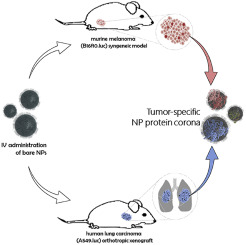当前位置:
X-MOL 学术
›
Biomaterials
›
论文详情
Our official English website, www.x-mol.net, welcomes your feedback! (Note: you will need to create a separate account there.)
A novel scavenging tool for cancer biomarker discovery based on the blood-circulating nanoparticle protein corona.
Biomaterials ( IF 14.0 ) Pub Date : 2018-10-13 , DOI: 10.1016/j.biomaterials.2018.10.011 Marilena Hadjidemetriou 1 , Zahraa Al-Ahmady 1 , Maurizio Buggio 1 , Joe Swift 2 , Kostas Kostarelos 1
Biomaterials ( IF 14.0 ) Pub Date : 2018-10-13 , DOI: 10.1016/j.biomaterials.2018.10.011 Marilena Hadjidemetriou 1 , Zahraa Al-Ahmady 1 , Maurizio Buggio 1 , Joe Swift 2 , Kostas Kostarelos 1
Affiliation

|
The prominent discrepancy between the significant investment towards plasma biomarker discovery and the very low number of biomarkers currently in clinical use stresses the need for discovery technologies. The discovery of protein biomarkers present in human blood by proteomics is tremendously challenging, owing to the large dynamic concentration range of blood proteins. Here, we describe the use of blood-circulating lipid-based nanoparticles (NPs) as a scavenging tool to comprehensively analyse the blood proteome. We aimed to exploit the spontaneous interaction of NPs with plasma proteins once injected in the bloodstream, known as 'protein corona', in order to facilitate the capture of tumor-specific molecules. We employed two different tumor models, a subcutaneous melanoma model (B16-F10) and human lung carcinoma xenograft model (A549) and comprehensively compared by mass spectrometry the in vivo protein coronas formed onto clinically used liposomes, intravenously administered in healthy and tumor-bearing mice. The results obtained demonstrated that blood-circulating liposomes surface-capture and amplify a wide range of different proteins including low molecular weight (MW) and low abundant tumor specific proteins (intracellular products of tissue leakage) that could not be detected by plasma analysis, performed in comparison. Most strikingly, the NP (liposomal) corona formed in the xenograft model was found to consist of murine host response proteins, as well as human proteins released from the inoculated and growing human cancer cells. This study offers direct evidence that the in vivo NP protein corona could be deemed as a valuable tool to enrich the blood proteomic analysis and to allow the discovery of potential biomarkers in experimental disease models.
中文翻译:

一种基于血液循环纳米粒子蛋白电晕的新型清除癌症生物标志物的工具。
在血浆生物标志物发现方面的大量投资与目前临床使用中的生物标志物数量非常少之间的显着差异突出了对发现技术的需求。蛋白质组学发现人类血液中存在的蛋白质生物标记物具有极大的挑战性,因为血液蛋白质的动态浓度范围很大。在这里,我们描述了使用基于血液循环的脂质纳米颗粒(NPs)作为清除工具来全面分析血液蛋白质组。我们的目的是利用NPs与血浆蛋白的自发相互作用,一旦注入血液,即称为“蛋白电晕”,以促进肿瘤特异性分子的捕获。我们采用了两种不同的肿瘤模型 皮下黑色素瘤模型(B16-F10)和人肺癌异种移植模型(A549),并通过质谱法全面比较了在健康和荷瘤小鼠中静脉内给药的临床使用脂质体上形成的体内蛋白质电晕。获得的结果表明,血液循环脂质体表面捕获并扩增了血浆分析无法检测到的各种蛋白质,包括低分子量(MW)和低丰度肿瘤特异性蛋白质(组织渗漏的细胞内产物)。相比下。最惊人的是,发现在异种移植模型中形成的NP(脂质体)电晕由鼠宿主反应蛋白以及从已接种和正在生长的人类癌细胞释放的人类蛋白组成。
更新日期:2018-10-14
中文翻译:

一种基于血液循环纳米粒子蛋白电晕的新型清除癌症生物标志物的工具。
在血浆生物标志物发现方面的大量投资与目前临床使用中的生物标志物数量非常少之间的显着差异突出了对发现技术的需求。蛋白质组学发现人类血液中存在的蛋白质生物标记物具有极大的挑战性,因为血液蛋白质的动态浓度范围很大。在这里,我们描述了使用基于血液循环的脂质纳米颗粒(NPs)作为清除工具来全面分析血液蛋白质组。我们的目的是利用NPs与血浆蛋白的自发相互作用,一旦注入血液,即称为“蛋白电晕”,以促进肿瘤特异性分子的捕获。我们采用了两种不同的肿瘤模型 皮下黑色素瘤模型(B16-F10)和人肺癌异种移植模型(A549),并通过质谱法全面比较了在健康和荷瘤小鼠中静脉内给药的临床使用脂质体上形成的体内蛋白质电晕。获得的结果表明,血液循环脂质体表面捕获并扩增了血浆分析无法检测到的各种蛋白质,包括低分子量(MW)和低丰度肿瘤特异性蛋白质(组织渗漏的细胞内产物)。相比下。最惊人的是,发现在异种移植模型中形成的NP(脂质体)电晕由鼠宿主反应蛋白以及从已接种和正在生长的人类癌细胞释放的人类蛋白组成。


























 京公网安备 11010802027423号
京公网安备 11010802027423号